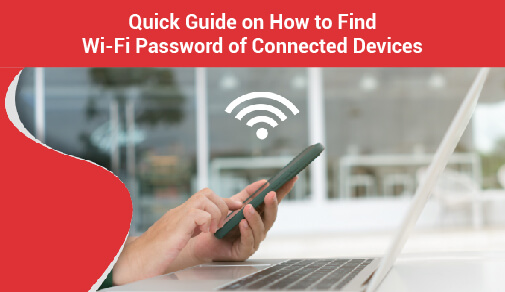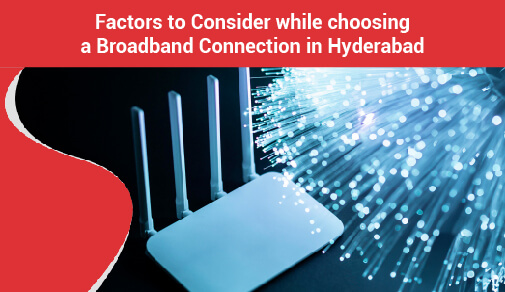Types of broadband connection - what to know before choosing one?
-
0
-
-
9 minutes

So, to function, even a home-based business requires a broadband internet connection. Without a broadband internet connection, it would be impossible for the most fundamental business operations like sending and receiving emails, downloading files accessing the internet.
However, with so many different kinds of connections, perplexing for individuals or business owners to choose the right one. Broadband is a crucial component of any organization in the current digital era. It provides larger bandwidth and faster speeds than dial-up zone connections.
It is possible to guarantee employee productivity, user pleasure, and total profitability by being aware of the fundamental differences and selecting the appropriate broadband internet connection. So, let’s dive into it!
What is meant by broadband internet?
Earlier, the only option for those who sought a stable internet connection was dial-up modems, which had slow download speeds due to their use of cable cabling, which could only send data at 10 Mbps (Mbps =1 million bits per second).
Nowadays, most individuals in both developed developing nations have access to broadband connections that offers plenty of room. Therefore, these modest speeds won't be an issue until their network isn't overloaded!
The term 'broadband' means high-speed internet connection that, in recent years, has supplanted dial-up. It is just the transfer of large data amounts through a fast internet connection. Compared to its predecessor, this provides substantially quicker speeds, more bandwidth a better overall experience.
Broadband connections come in various forms, each with unique benefits and drawbacks. The Federal Communications Commission (FCC) means a broadband connection with a minimum download speed of 25 Mbps an upload speed of 3 Mbps.
Many methods, including cable, DSL, fibre optics, and satellite, can deliver broadband. But one needs to be aware that the speed and cost of broadband will depend on the delivery method. Furthermore, the definition of broadband may differ from nation to nation.
For instance, the FCC in the US has established a benchmark name for broadband as an internet connection with download and upload rates of 25 Mbps 3 Mbps, respectively. Different standards for a high-speed internet connection have been established in other nations, such as Australia and the UK.
For instance, in India, broadband connections must reach the 2 Mbps speed requirement set by the TRAI (Telecom Regulatory Authority of India). However, a business internet connection with download and upload rates of 25 Mbps or higher qualifies as a broadband connection.
Now we have explained the basics of broadband. Let’s go deeper into the types of broadband service.
Types of Broadband Connections:
Various signals must be followed and transmitted within the spectrum of broadband services got a large bandwidth. There are different high-speed sharing technologies used in broadband, gets divided into the following steps:
1. Digital Subscriber Line (DSL)
DSL, the most popular technology for workplace broadband connections, transmits high-speed internet over a regular copper telephone line. It is an option accessible and reasonably priced. How far businesses are the phone exchange may impact its speeds.
The connection will be slower the further away they are. With a maximum downstream data rate of 24 Mbps and an average upstream data rate of 640 Kbps, DSL is an asymmetric digital subscriber line (ADSL) oriented technology.
An Asymmetric Digital Subscriber Line (ADSL) is a way of DSL that transmits data over a single copper twisted-pair line using separate frequencies for upstream downstream traffic. It is thanks to this technology that download speeds are now faster.
Broadband internet service can be delivered over the currently operational classic twisted-pair copper telephone portals using ADSL technology. Additionally, ADSL offers service providers to deliver alluring new services, including VoIP, IPTV (Internet Protocol television) VoIP (Voice over the Internet Protocol).
The primary drawback of DSL is its distance restrictions. The connection will be slower the further businesses are from the phone exchange.
Multiple users bridged to the same DSLAM (distributed office equipment that links subscriber lines to the main network) experience the shared bandwidth problem with DSL. During busy hours, this may result in congestion and slower speeds.
In conclusion, DSL is a fantastic choice if a business is seeking a widely accessible and reasonably priced business internet portal. However, factors like distance and congested bandwidth can slow down its rates.
2. Cable Modem
A cable modem is an additional common option for internet access in offices. The coaxial cables that enable cable TV services use this technology. As a result, it's frequently known as 'cable broadband' or simply 'broadband over cable.'
The infrastructure for cable internet and cable TV is the same. It provides fast speeds and is generally accessible in cities. However, being pricey and because of congestion during rush hours, it often moves more slowly.
Coaxial cables, also used for cable TV, are used in cable broadband technology to deliver high-speed internet service. Cable companies offer customers who reside in locations that have installed this service.
Cable broadband's key benefit is the provision of fast speeds, which makes it perfect for organizations to push massive volumes of data. Additionally, cable providers frequently offer clients who sign up for their internet TV service discounts.
The biggest drawback of cable connection is the potential cost. Additionally, cable companies' speeds may change depending on the time of day the volume of users on the network. Congestion at peak hours can cause speeds to decrease.
In conclusion, cable broadband is a fantastic choice if high speeds provider discounts are required. However, this is costly, and the speeds it offers can differ based on the time of day network congestion.
3. Fiber
The newest quickest type of internet connection for offices is fibre. High-speed data delivery is accomplished using slender glass/plastic fibres. Compared to other workplace internet connection options, fibre has several benefits, including faster speeds, reduced latency, and improved reliability.
The speed of fibre becomes vital. Fibre optic cables have a larger data capacity than conventional copper wires, which enables them to operate at significantly higher speeds. Fibre optic cables are not impacted by distance, unlike copper lines. It implies that even if users live farther from the closest phone exchange, they can still access high-speed fibre internet.
Fibre optic cables are protected from weather other physical harm since they are buried. Fibre optic cables are superior to copper wires because they are less susceptible to interference, making them the best choice for companies that use VoIP/other delicate applications.
Another benefit of fibre is low latency. The time between sending a request and receiving a response is known as latency. For organizations that depend on real-time apps, including VoIP/video conferencing, fibre has lower latency than other office internet connections.
In comparison to other business internet connection types, fibre is also more dependable. It implies a lower likelihood of outages or data loss—the primary drawback of fibre price. Traditional office internet portals might cost around ten times less than fibre connections.
If users require the highest speeds available don't mind spending a little more money, fibre is the best choice. It provides excellent reliability, fast speeds, and low latency. In contrast to other possibilities, it’s pricey.
In summary, fibre optic wires have many benefits over conventional copper wires, such as faster speeds, less latency, and increased reliability. Fibre is the best option if businesses require an office internet connection works in heavy traffic.
4. Wireless
As technology advances, wireless connections turns more prevalent because wireless internet transmits data using radio waves and can use locations without wired infrastructure.
The flexibility of wireless workplace internet is by far its primary benefit. Office structures, warehouses the open air can all benefit from wireless internet use. Additionally, wireless internet is much simpler to establish than other business internet connection options.
High speeds are one further benefit of wireless business internet. The most recent gen of wireless routers is capable of gigabit-per-second speeds. Wireless is perfect for companies that must send massive data amounts.
A wireless connection is a fantastic choice if businesses require flexibility and fast connections. They must choose a suitable placement for the router because it might be sensitive to interference. Wireless office internet's biggest drawback is the possibility of interference.
Weather conditions other electronic equipment are two variables that might affect radio signals. It implies that if users are utilizing wireless internet in a popular area, they can experience slower speeds or even outages.
In conclusion, wireless office internet is a fantastic option for companies that want quick speeds and simple installation. Ensure a suitable place for the router to prevent interference problems.
5. Satellite
Businesses in rural zones or with limited access to wired infrastructure can consider satellite office internet. Since satellites are utilized to transfer data, satellite office internet can be accessed from any location with a clear sky view.
The easy availability of satellite office internet is an added benefit. Across the globe, you can use satellite office internet, irrespective of demographics. Additionally, satellite office internet cannot be impacted by weather, which turns into a viable option for companies with locations in distant areas.
High speeds are another benefit of satellite office internet. Businesses transporting huge volumes of data might benefit greatly from satellite connections, which can provide average speeds of around 50 Mbps.
Latency is the biggest drawback of satellite office internet. The latency of satellite communications, which can reach 500 ms, makes them unfit for real-time apps. Although satellite internet can be infancy, it has much potential.
Persons between 44 and 53 degrees latitude can access Elon Musk's Starlink in some regions of the United States Canada. It is currently in beta and operating at 100 Mbps or such.
In summary, firms in remote locations that require fast speeds should consider satellite office internet. The significant latency of satellite internet can render it impractical for real-time apps.
6. Broadband instead of Powerlines (BPL)
Office internet portals that use the electrical grid to transport data are known as 'broadband over powerlines' (BPL). Businesses situated in locations with limited access to the wired portal should consider BPL.
The massive benefit of BPL is it's readily available. BPL is an excellent option for companies with locations in rural zones because anywhere there is an electrical infrastructure. Additionally, BPL is unaffected by weather, making it a viable option for companies situated in distant places.
BPL's quick speeds are a further benefit. Businesses must transport significant volumes of data using BPL connections, which can provide speeds of around 50 Mbps.
BPL's latency is its biggest drawback. Due to its high latency of around 500 ms, BPL connections may not be appropriate for visual applications. Additionally, BPL is sensitive to connection, which can slow down or disrupt service.
The Bottom Line:
For many households and organizations, broadband internet is a necessity. Thus, regarding internet alternatives for the company, owners must ensure the benefits and drawbacks of different connections before deciding.
Their specific requirements and financial constraints will determine the kind of connection they choose. Consider various aspects before selecting a broadband service for business internet, including speed, connection type, price, contract, and security.
But whatever users decide, they need to make sure it is dependable and provides the speeds they require to keep the business operating efficiently. Most essential, it is better to get the advice of a professional to ensure they are obtaining the best workplace internet connection for the organization.







